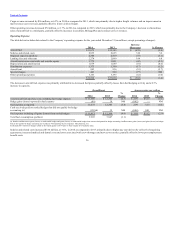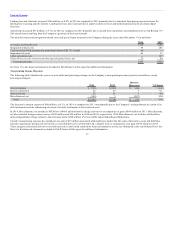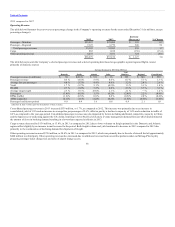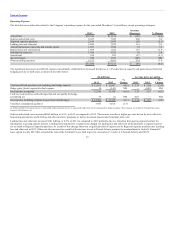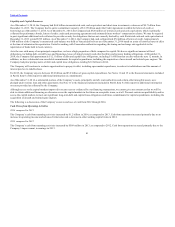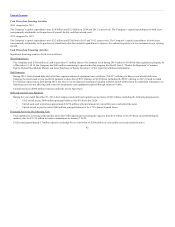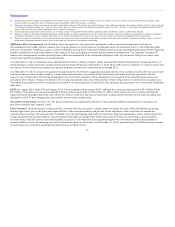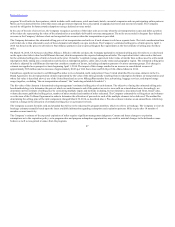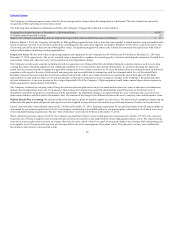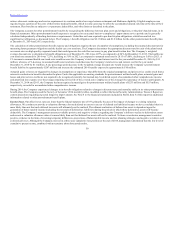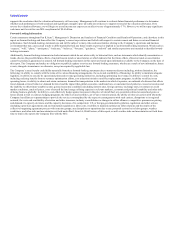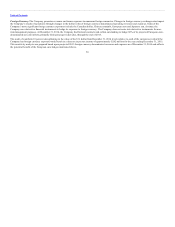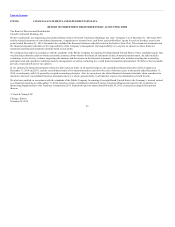United Airlines 2014 Annual Report Download - page 46
Download and view the complete annual report
Please find page 46 of the 2014 United Airlines annual report below. You can navigate through the pages in the report by either clicking on the pages listed below, or by using the keyword search tool below to find specific information within the annual report.
Table of Contents
participates, as to which United and each of the signatory airlines have provided indirect guarantees of the debt. As of December 31, 2014, the Company’s
contingent exposure was approximately $239 million principal amount of such bonds based on its recent consortia participation. The Company’s contingent
exposure could increase if the participation of other air carriers decreases. The guarantees will expire when the tax-exempt bonds are paid in full, which range
from 2015 to 2041. The Company did not record a liability at the time these indirect guarantees were made.
Critical accounting policies are defined as those that are affected by significant judgments and uncertainties which potentially could result in materially
different accounting under different assumptions and conditions. The Company has prepared the financial statements in conformity with U.S. GAAP, which
requires management to make estimates and assumptions that affect the reported amounts in the financial statements. Actual results could differ from those
estimates under different assumptions or conditions. The Company has identified the following critical accounting policies that impact the preparation of the
financial statements.
Passenger Revenue Recognition. The value of unused passenger tickets is included in current liabilities as advance ticket sales. The Company records
passenger ticket sales and tickets sold by other airlines for use on United as passenger revenue when the transportation is provided or upon estimated
breakage. Tickets sold by other airlines are recorded at the estimated values to be billed to the other airlines. Differences between amounts billed and the
actual amounts may be rejected and rebilled or written off if the amount recorded was different from the original estimate. When necessary, the Company
records a reserve against our interline billings and payables if historical experience indicates that these amounts are different. Non-refundable tickets
generally expire on the date of the intended flight, unless the date is extended by notification from the customer on or before the intended flight date.
Fees charged in association with changes or extensions to non-refundable tickets are recorded as other revenue at the time the fee is incurred. The fare on the
changed ticket, including any additional collection of fare, is deferred and recognized in accordance with our transportation revenue recognition policy at
the time the transportation is provided. Change fees related to non-refundable tickets are considered a separate transaction from the air transportation because
they represent a charge for the Company’s additional service to modify a previous sale. Therefore, the pricing of the change fee and the initial customer order
are separately determined and represent distinct earnings processes.
The Company records an estimate of breakage revenue on the flight date for tickets that will expire unused. These estimates are based on the evaluation of
actual historical results and forecasted trends. Refundable tickets expire after one year from the date of issuance.
In May 2014, the Financial Accounting Standards Board (“FASB”) amended the FASB Accounting Standards Codification and created a new Topic 606,
Revenue from Contracts with Customers. This amendment prescribes that an entity should recognize revenue to depict the transfer of promised goods or
services to customers in an amount that reflects the consideration to which the entity expects to be entitled in exchange for those goods or services. The
amendment supersedes the revenue recognition requirements in Topic 605, Revenue Recognition, and most industry-specific guidance throughout the
Industry Topics of the Codification. The amendments will become effective for the Company’s annual and interim reporting periods beginning January 1,
2017. Under the new standard, certain airline ancillary fees directly related to passenger revenue tickets, such as airline change fees and baggage fees, are
likely to no longer be considered distinct performance obligations separate from the passenger travel component. In addition, the change fees which were
previously recognized when incurred, will likely be recognized when transportation is provided. The Company is evaluating other impacts on its
consolidated financial statements.
Frequent Flyer Accounting. The Company’s MileagePlus program is designed to increase customer loyalty. Program participants earn miles by flying on
United and certain other participating airlines. Program participants can also earn miles through purchases from other non-airline partners that participate in
the Company’s loyalty
46


